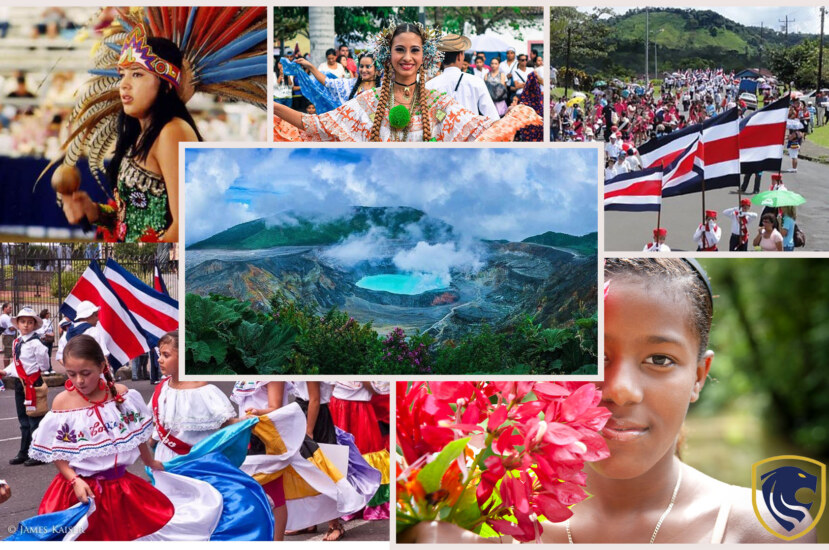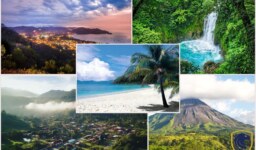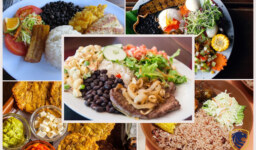Welcome to Costa Rica’s lively world, where enthralling culture and warm-hearted people blend harmoniously. This fascinating region, nestled in Central America, is marked by its rich past and distinct way of life. Costa Rica, sometimes known as the “Rich Coast,” is a country where the concept of Pura Vida, or pure life, pervades every facet of society. So, this page delves into fascinating facts about Costa Rica’s culture and people, revealing the essence of Costa Rican living. From the famed Pura Vida lifestyle to the country’s commitment to environmentally responsible methods, every element offers a vivid image of this magnificent country. Join us on an adventure to discover the beauties that have made Costa Rica a cultural jewel in the heart of the Americas.
Pura Vida
Pura Vida, the heart and soul of Costa Rican culture, captures the essence of the country. It’s a daily mantra that means “pure life,” and it expresses a positive mindset and thankfulness. Costa Ricans, known as Ticos and Ticas, embrace this attitude by appreciating the simplicity of life. Pura Vida represents happiness, contentment, and a stress-free way of life. It’s more than just a phrase. It’s a way of life, a sense of cultural identity. Ticos greet each other with “Pura Vida” and use it to express how happy they are. Moreover, this mentality may be found in many aspects of Costa Rican society, from cordial encounters to environmental awareness. Costa Ricans value their well-being and relationships as they embrace Pura Vida. It symbolizes their great connection to the environment, as seen by their devotion to eco-friendly methods and the preservation of luxuriant biodiversity.

Pura Vida
Pura Vida is more than a catchphrase. It embodies Costa Rica’s warm hospitality, love of life, and harmonious coexistence with the environment, making it a vital thread in the colorful tapestry of Costa Rican culture.
High Literacy Rate
Costa Rica has an outstanding high literacy rate, owing to its strong educational system. Costa Ricans emphasize knowledge with an emphasis on learning. Because to the country’s commitment to education, it boasts one of the highest literacy rates in the Americas. Education is a basic right, not merely a priority. So, the schools are easily accessible and provide high-quality education to all students.

High Literacy Rate
The emphasis on reading has resulted in a well-informed society, encouraging critical thinking and inquiry. Literacy is a cornerstone, empowering citizens and instilling pride in their intellectual accomplishments. This dedication to education has set the road for Costa Rica’s prosperity, ensuring that future generations are prepared to succeed in a global environment. In conclusion, Costa Rica’s high literacy rate is a symbol of the country’s continuing commitment to knowledge, building a culture in which learning is respected and appreciated.
Abolished Army
Costa Rica is a one-of-a-kind country that distinguishes out for an uncommon reason. It dissolved its army in 1948. Costa Rica’s identity has been determined by this choice, which was based on a commitment to peace. Costa Rica’s lack of a permanent military distinguishes it from its neighbors, maintaining stability and confidence. Rather of investing on military force, the country’s resources are directed into education, healthcare, and social welfare.

Abolished Army
This decision has resulted in the establishment of a quiet sanctuary in Central America, fostering unity and collaboration. Costa Ricans are ecstatic with this choice, which embraces a vision of a peaceful society. In addition, Costa Rica has thrived economically and culturally due to the absence of armed wars. Costa Rica has become a symbol of peace in a volatile world as a result of this historic decision. The abolition of the army represents the principles of the country, establishing a society in which diplomacy and education triumph over conflict and bloodshed.
Ticos and Ticas
“Ticos” and “Ticas” are lovable Costa Rican words that show their warm and welcoming demeanor. Locals and visitors alike use these nicknames with love. The diminutives “tico” and “tica” reflect the country’s welcoming and accessible character. Also, Ticos and Ticas are famed for their friendliness, with open arms embracing outsiders. Friendship is strongly embedded in their social fabric, producing a pleasant environment for travelers.

Ticos and Ticas
The phrases represent togetherness and foster a sense of belonging among Costa Ricans. Ticos and Ticas have a feeling of belonging and pride, whether they live in big metropolis or isolated countryside. Their pleasant approach extends to guests, making Costa Rica a location where visitors easily feel at home. Ticos and Ticas exemplify the essence of Pura Vida, exuding happiness and friendship while delivering unforgettable experiences for everyone they meet.
Ecotourism Pioneers
Costa Rica is a global leader in ecotourism, providing a great example for the rest of the globe. The country’s dedication to preserve its diverse biodiversity has made it a forerunner in sustainable tourism. Because, Costa Ricans, or Ticos, value their natural environment, which inspires eco-friendly projects. The magnificent jungles, diversified animals, and pristine beaches of the country are all carefully protected. Ecotourism is more than simply a business in this town. It’s a way of life. Costa Rica’s national parks, such as Manuel Antonio and Corcovado, are examples of conservation initiatives that welcome responsible visitors.

Ecotourism Pioneers
Locals regularly participate in environmentally beneficial initiatives, such as recycling and renewable energy. Ticos realize that living in harmony with nature helps both people and the world. So, there are several eco-lodges and animal sanctuaries that provide immersive experiences while protecting the environment. Tourists rush to Costa Rica to observe the country’s green initiatives firsthand, making it a popular destination for environmentally minded vacationers. Costa Rica’s foresight in ecotourism demonstrates a peaceful balance between humans and environment, creating an indelible impression on everyone who come.
Blue Zones
Costa Rica is honored to be home to one of the world’s five Blue Zones, areas where people live noticeably longer and healthier lives. The Nicoya Peninsula, in particular, is known for having a high number of centenarians. Longevity is ascribed to a combination of good lifestyle choices and strong social relationships in this country. Their outstanding well-being is attributed to plant-based diets, regular physical activity such as walking and gardening, and a feeling of purpose. Blue Zones’ community-centric culture creates close-knit connections, lowering stress and enhancing mental wellness.

Blue Zones
Moreover, elders are recognized and esteemed members of society who perform active roles. Individuals are driven and fulfilled when they have a “plan de vida” or a life purpose. Centenarians in Blue Zones not only live longer lives, but also have a superior quality of life, retaining independence and vigor well into old age. The lessons learned from these Blue Zones have sparked global attention, pushing individuals all over the world to adopt healthy behaviors and form supportive communities, evoking the spirit of Pura Vida in many aspects of life.
Coffee Culture
Costa Rica’s coffee culture is firmly ingrained in the fabric of everyday life. Coffee is more than simply a beverage. It is a cultural tradition and a source of national pride. The rich volcanic soil and optimum climate are suitable for coffee growth. The “cafeta” (coffee farmer) is a recognized character who preserves traditional ways while accepting contemporary ones. Also, coffee estates in the Central Valley and Tarraz area, for example, provide comprehensive tours that allow tourists to observe the careful process from bean to cup. Coffee is served strong and black, representing the brew’s purity.

Coffee breaks, also known as “sobremesa,” are treasured opportunities for mingling and bonding. Costa Rican Coffee culture is more than just about flavor; it also represents warmth and welcome. Costa Rican coffee has received international recognition for its exceptional quality and distinctive tastes. Coffee estates are frequently converted into eco-friendly resorts, supporting sustainable tourism. Coffee is more than just a beverage for Costa Ricans. It fosters interactions and conversations, making it an essential aspect of the country’s dynamic way of life.
National Symbols
Costa Rica’s national emblems provide witness to the country’s rich cultural past. The national bird is the yigüirro, a clay-colored thrush known for its lovely singing that heralds the advent of the rainy season. The guaria morada orchid, with its brilliant purple blossoms, is the country’s official flower, representing the country’s natural beauty. In addition, the national flag has five horizontal stripes that depict the country’s many geographies and ethnic groupings. Costa Rica’s agricultural richness is represented by volcanoes, the Pacific and Atlantic seas, ships, and coffee and banana trees on the coat of arms. The national anthem, written in 1852, depicts the history and patriotism of the country.

National Symbols



